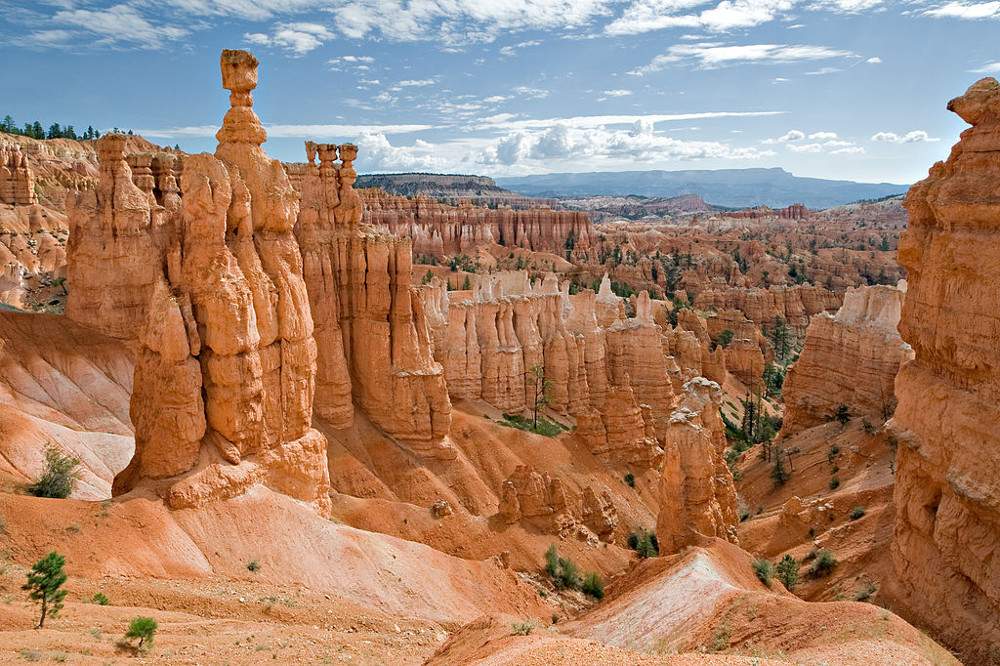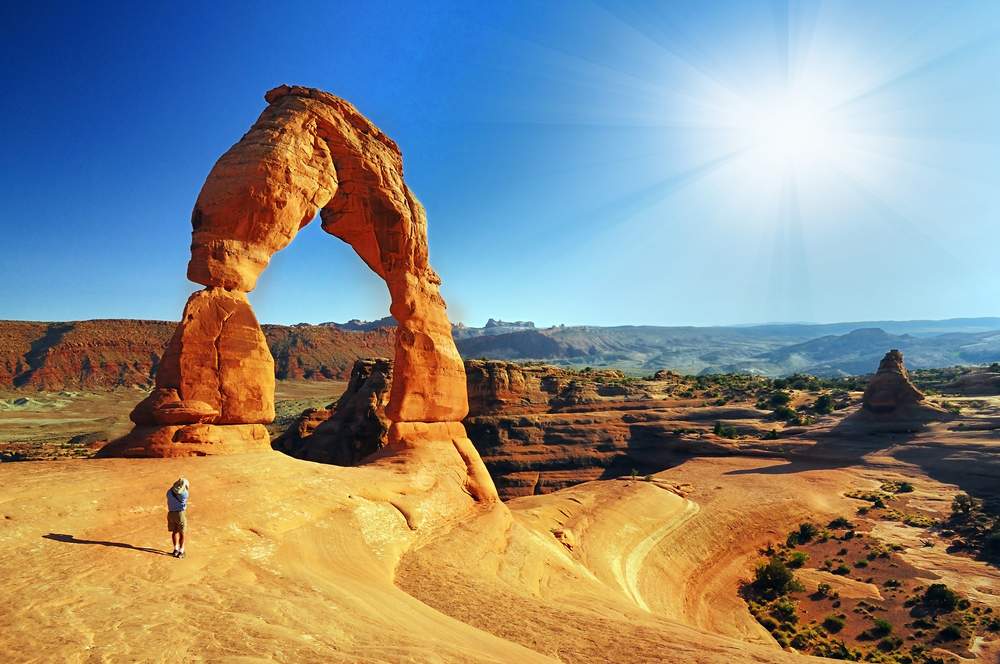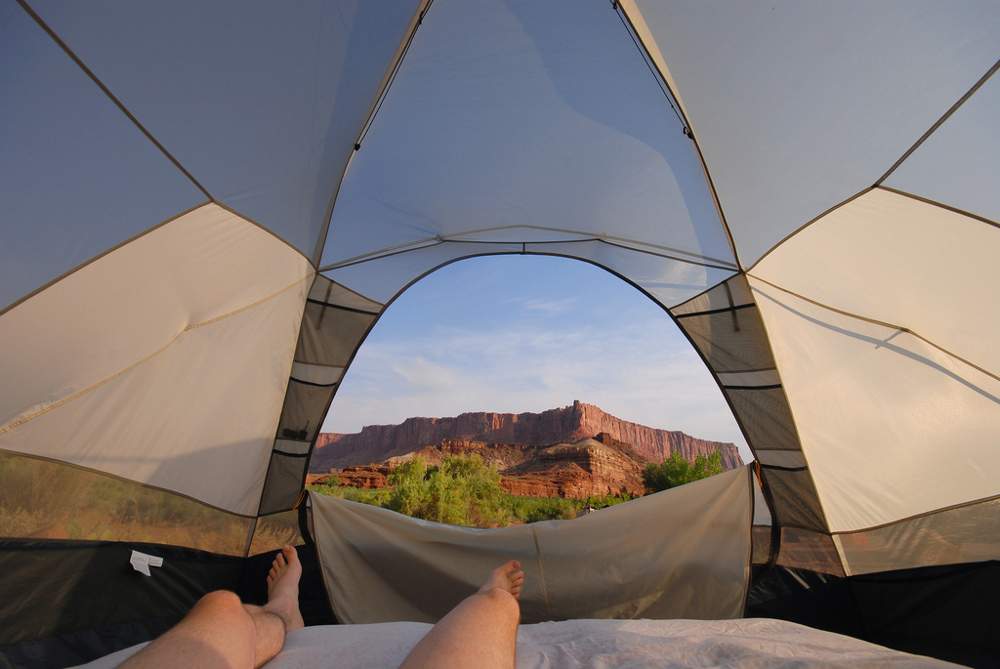If you haven’t had a chance to check out one of the country’s national parks but would like to see what all the fuss is about, there’s no time like now to fill your water bottle and set out to explore what has become known as America’s Best Idea.
Add a US National Parks leg to your big trip
When planning a big, long-term trip, we encourage people to choose a few pillars, highlights, or must-do’s to plan their larger itinerary around. It helps shape your route and allows you to fill in the holes as you go.
If you’re looking to add time in the United States to part of a longer trip, consider planning your time there around a handful of US National Parks. The route below is an example of what you could do.
Sign up for a free BootsnAll Membership to build, search, price, and book a route like this today!
Trip highlights
- Fly into Denver and travel overland to Rocky Mountain National Park in Colorado
- Drive through the Rockies and into Utah, basing yourself in Moab to explore Arches and Canyonlands.
- Stay in Utah and head to Bryce and Zion.
- Head into Arizona to see a true world wonder in The Grand Canyon.
- Then over to Vegas to catch your next flight.
What you need to know
The National Park Service consists of over 400 national parks, many of which offer overnight lodging or camping and some of which are day-use only. As a U.S. federal agency, the maintenance and development of the parks is made possible through government funding and user fees and donations. Many parks charge entry fees, which range from $5.00-$25.00 per car per week. Generally, if a park is popular, the entry fee will cost more, but don’t judge a park by its fee; there are many off-the-radar, no-fee parks worth checking out.
If you purchase an America the Beautiful National Parks and Federal Recreation Lands Pass (currently $80.00), you get unlimited entrance to all National Park Service and federal recreation lands for one year. There are similar passes for seniors and U.S. citizens or residents with permanent disabilities.
When you first enter the park, stop by the visitors’ center for answers to your questions. Park rangers and volunteers are able to provide information on campground vacancies, weather conditions and park activities. They can also answer questions about flora and fauna, park history, geology and astronomy. While you’re here, pick up a complimentary copy of the park’s newspaper, which includes a map, schedule of ranger programs, hiking trails and information about road closures and hours of operation.
Most parks also have a small museum, which provides background information about the significance of the area.
National Park planning

The national parks are a popular destination, especially because they are relatively inexpensive compared to many vacation alternatives. Therefore, it is important to plan your visit to a national park in advance, especially if you want to visit a popular park like Yellowstone, the Everglades or the Rocky Mountains for more than a day.
You can reserve camping spots up to a year in advance at many parks, and you’ll need to be just as assertive to get backcountry permits in some parks as well. It is possible to visit national parks for a single day, but some are so vast that you wouldn’t see much if you tried to do so. To avoid feeling frustrated and rushed by a national park visit, plan on spending at least a few days, don’t try to cram everything into one visit and make your plans well in advance.
Though a few parks are large and wildly popular, others are small and uncrowded enough that you could take off for a weekend trip without much planning. Read up on your park of choice at the National Park Service website for information on advance planning and reservations.
One thing to keep in mind when planning a national park trip is the weather and season.
- Summer is a popular time to visit the parks, and all available park facilities are usually open during summer months. Depending on where you visit, plan to wear sunscreen and bug spray and drink lots of water.
- Spring and fall are a good time to plan a trip in the southern part of the country when animals are out and flowers are blooming.
- Some parks are not open in the winter, and if you visit a park during this time of year, prepare for cold and snowy conditions. Visiting in the winter usually guarantees the cheapest prices for lodging, and you won’t have to fight the crowds.
Things to do

National parks welcome people who want to spend days isolated and surrounded by nature, but they’re also good for families and friendly for newbies to the great outdoors. Regardless of the kind of traveler you are, the complimentary newspaper and map you pick up at the visitors’ center will help you plan your visit by highlighting the must-do and must-see activities.
Scenic driving
A scenic driving tour with stops at the overlooks will keep you on the tourist path, but it is one of the best ways to become acquainted with the layout of a park. Scenic drives also give you the opportunity to see some of the best views without having to stray far from the car. Glacier National Park’s Going-to-the-Sun Road and the drive along the Grand Canyon’s South Rim are two examples of popular scenic drives, though both can be crowded during high season.
Hiking
If you’d like to get a little closer to nature, thousands of miles of hiking trails cross the parks. These trails—which range from short, paved interpretive paths to strenuous, unmarked, multi-day treks—are a good way to get off the main road. Most parks have a nice mix of short and long trails, and several parks also offer backcountry hiking options as well. Backcountry hiking and camping usually requires a special permit, and each park has different requirements regarding time, fees and reservations. Check each park’s backcountry regulations in advance of traveling to the park, as backcountry permits in popular parks sell out fast.
Other activities
Depending on the national park, there might also be opportunities for horseback riding, rafting, rock climbing and other outdoor activities. Nearly every park offers ranger-led walks, which are generally a couple hours long, and ranger-led talks in the evening about specific park-related topics such as geology, wildlife, folklore and notable historic figures.
What to pack
Whether you’ll be visiting a national park for a day or a week, there are a few things you should pack and keep in mind.
- First, arrive in the park with a full tank of gas in your car. A few parks have gas stations; all of them overcharge for the service.
- Also, make sure your car is in good working condition, and come with a spare tire and basic repair supplies.
- Bring a camera with a full battery and an extra memory card.
- Always carry water with you, and refill your drinking containers when given the opportunity.
- Dress appropriately for the terrain with tennis shoes, hiking boots or thick-soled, strapped sandals.
- Keep a jacket or sweatshirt with you, and, if you are traveling in the summer or at high elevations, pack sunscreen as well.
- If you’ll be staying for more than one day in a national park, you’ll need to come prepared with camping gear or an RV.
- Regardless of how you stay in the park, you’ll need to bring food and some way to prepare it (probably a camping stove).
- Tent camping requires much more gear than RV camping and books have been written on camping gear, but basic equipment includes a tent, sleeping bag, headlamp or lantern, dishes and cleaning supplies.
Hiking requires special preparation as well.
- Even if you plan on being on the trail for only an hour, carry:
- a day pack with a first aid kit
- plenty of water and snacks
- rain gear
- matches, a headlamp, and a whistle.
- Consult park rangers before hiking for information on weather and trail conditions, and do not hike beyond your ability
Where to stay

There are four options on places to stay in national parks:
- In a campground in a tent
- In a campground in an RV
- In the park’s lodge or cabins
- In the backcountry.
If you want to stay in a campground, you need to make your reservations early. Most national parks manage reservations through the federal recreation reservation service, but check with each park for specifics.
Campgrounds in the parks fill up early, but reservationists through the recreation service can help you find private and national forest campgrounds located outside the parks if necessary. In addition to sites that can be reserved, many parks also have first-come, first-served sites. Campgrounds may have modern toilets and potable water, or they may be primitive with drop toilets and no potable water. Check the specifics before you book so that you are adequately prepared.
Some of the larger and older parks have historic lodges and cabins. These also need to be reserved in advance, and though they can be pricey in the high season, their convenient location in the parks and accessibility to electricity and running water often make the cost worthwhile.
Many parks also allow people to camp in the backcountry, though you’ll likely need a permit, and you may need to make reservations for backcountry campsites. Some parks have specific rules about where and how long you can camp in the backcountry; others are more lenient, especially if they aren’t as popular. Each park is different, so do your research before you leave for your trip.
And if “roughing it” just isn’t your style, you can pick a city close to several national parks and make trips into the parks each day.
To read more about US National Parks and traveling in the United States, check out the following articles:

Photos by: Lance and Erin, Luca Galuzzi, Grand Canyon NPS, Rob Lee, Rob Lee, tusharkoley, Pung